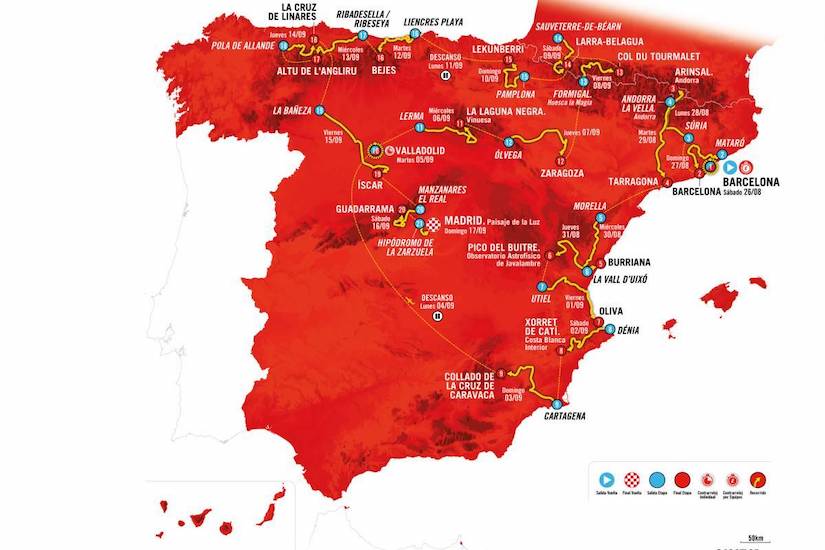 Set to kick off from Barcelona on this last weekend of August, for only the second time in its history to start from the Catalan megalopolis after the 17th edition in 1962, La Vuelta 23 is under the Olympic sign.
Set to kick off from Barcelona on this last weekend of August, for only the second time in its history to start from the Catalan megalopolis after the 17th edition in 1962, La Vuelta 23 is under the Olympic sign.
The event’s headquarters are getting set up at the Complejo Deportivo Municipal La Mar Bella, site of the badminton competitions at the 1992 Olympic Games, and the day after the inaugural team time trial around the Olympic port, the first finale for punchy finishers will take place on the Montjuic hill near the Lluis Companys Olympic Stadium, which still reverberates with the exploits of Carl Lewis, Linford Christie and Javier Sotomayor in track and field. This is FC Barcelona’s home ground this football season due to works in progress at the Camp Nou. It is widely acknowledged that sport has had a positive impact on the city over the last three decades.
The last two winners of La Vuelta, Primoz Roglic in 2019, 2020 and 2021 and Remco Evenepoel in 2022, are the reigning Olympic and world champions for time trial. Their duel in this speciality, in Valladolid on 5 September, has connoisseurs salivating in anticipation, but the mileage (25) suggests that “Pucela” (the nickname of the city of Castilla y León) won’t necessarily determine the winner of La Roja (the red leader’s jersey) in Plaza de Cibeles in Madrid on 17 September, given that the mountains to follow are conducive to hard-fought battles.
Once again, this year’s La Vuelta explores some unusual difficulties. Five of the ten summit finishes are unprecedented: Arinsal, in Andorra (stage 3, after the Ordino pass that requires the protagonists to be in top condition from the beginning), Caravaca de la Cruz, in the Murcia region (stage 9), Larra-Belagua, in Navarra (stage 14), Bejes, in Cantabria (stage 16), and La Cruz de Linares, in Asturias (stage 18).
But the two highlights of the route are legendary venues in cycling: the Col du Tourmalet in France and the Alto de l’Angliru. They were already supposed to form the two major stages of La Vuelta 20 until the French authorities closed the roads to the race in the wake of the Covid-19 pandemic. This time, they are separated by five days, on 8 and 13 September (stages 13 and 17).
The Tourmalet is the most visited pass by the Tour de France: 80 times, since the first passage through the Pyrenees in 1910. Norway’s Tobias Halland Johannessen was first up there last month. Jonas Vingegaardtook the Maillot Jaune for good on those slopes, leading the group of the favourites at the summit on stage 6, but La Vuelta is taking the route in the opposite direction, on the western versant from Luz-Saint-Sauveur.
At the top is the stele of Jacques Goddet, the historic boss of the Grande Boucle, and there’s a statue of a naked cyclist known as “the giant”. In the 1960s, this was the favourite pass of Federico Martín Bahamontes, the first Spanish Tour de France winner, who recently died at the age of 95. Before La Vuelta 23, the Tour de France Femmes avec Zwift also installed a finish line at the summit of the Tourmalet, which crowned Dutchwoman Demi Vollering.
While the legendary pass in the French department of Hautes-Pyrénées is steeped in history, the Alto de l’Angliru in Asturias is a marker of modernity in cycling. While the slopes of the Tourmalet are regular, especially on the western versant, those of the Angliru require changes of pace.
On the first three visits by La Vuelta, in 1999, 2000 and 2002, the maximum gradients of 23.5% at Cueña les Cabres seemed monstrous. Since then, technological advances firstly experienced in mountain biking have made the riding more accessible. It’s where Alberto Contador won his very first and very last stage on La Vuelta (in 2008 and 2017).
Hugh Carthy, in 2020, became the eighth and last Angliru stage winner to date. Roglic, the eventual overall winner, had momentarily lost La Roja, which enables pure climbers to start with the highest ambitions this year.
The great equation for La Vuelta 23 is therefore whether it will be won at the Tourmalet and defended at the Angliru, or vice versa. More subtly, it will be up to the contenders for overall victory not to lose at the Tourmalet and then to impose their leadership in Asturias, not only at the Angliru but also the following day, with the double ascent of Puerto de la Cruz de Linares.
But beware, La Vuelta always has one last trick up its sleeve. On the eve of the grand finale in the Spanish capital, no fewer than ten climbs are listed in the Sierra de Guadarrama over an unusual distance of more than 200 kilometres, making it the longest stage of the race. It’s reminiscent of the penultimate stage in Galicia in 2021, just the right thing for a last-minute twist! – www.lavuelta.es


































